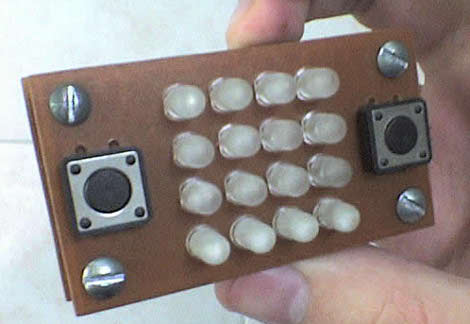
What we need in today’s handhelds is LESS resolution. Take a look at the video after the break to see the exciting action that [Bruno Pasquini] 4×4 LED matrix handheld game delivers. The device is made up of 16 bi-color LEDs, four buttons, and a PIC 16F628. There’s no schematic yet but it looks like there’s no need for shift registers, just some transistors to handle the current load for the rows of each color. We’ve seen a 64-pixel handheld that plays Super Mario Brothers, but this portable brings a top scrolling racing game with just 25% of that display size.
[youtube=http://www.youtube.com/watch?v=bilCpOhulCI]
[Thanks Mike]














That’s beatiful. Really.
Looks like a hard coded map for the game. What, no dynamic generation algorithm?
No but seriously, nice build. The multicolor LED’s could lead to some interesting games. The two buttons is a bit of a limitation, though.
is it stereoscopic 3d compatible?
@smaddox
I’m sure you could easily interface the PSP joystick as we’ve seen done int he past if you wanted to give more movement.
Dynamic generation was the first improvement I thought of. Shouldn’t be terribly difficult to achieve, right? I guess you could have predefined maps and pseudo-randomize the order.
@biozz Well, I am viewing it using both eyes and he pulled it forward in the frame – so YES.
I got very good at that game when I figured out how to code it for my calculator instead of learning math.
It’s like tetris from the point of view of a fly trapped in the middle of the game.
@Spork
You could achieve randomisation in an even simpler way: Just create a large set of different obstacles and let the uC mix them together to a map of lets say 200 obstacles. After the player crosses the 200. the uC puts a new map together and the player advances to the next level.
I remember one of the very earliest handheld electronic games — this would have been in the late 1970’s, when scientific calculators were a luxury only actual scientists could afford and a 4-function calc would set you back thirty bucks. There were games in calculator form factor (and also costing twenty or thirty bucks) using 7-segment displays to implement games like this. I remember one in particular was a “football” game where you tried to advance from left to right on the top, middle, or lower line against “blockers” that would come at you.
Hmmmm, I’m getting an idea…
@8-[
Yeah, that’s exactly what I was thinking. When I said “map”, I was thinking like 2-6 rows of graphics that make up a little obstacle or something.
Hmmm. Seems like this game only requires bi-color LEDs in the bottom row. Nice build, though…
Real retro, let me get my bell bottoms on (or whatever the hell the wore in the 70’s I can’t remember.)
But can it play Crysis?
@localroger, I had that game as well.
You could either run or pass. The run formation looked like this. Your linebacker was obviously on the left.
–
–
–
If you passed, it looked like this
—
–
Leftmost guy was the QB, top right was the blocker, and bottom right was your receiver. Passing was cool because your pass was represented by a decimal point that went left -> right across the screen. After you caught the pass, you’d get to run and pile up extra yardage.
The game was easy to beat when you got a few patterns down, but still a lot of fun.
Argh, the editor screwed up my formatting >:-<
you could generate it randomly, so long as you ensure that path remains clear and no dead ends. wouldnt be too hard either.
I say go for even lower resolution: http://en.wikipedia.org/wiki/Simon_%28game%29
localroger is probably remembering the Mattel Auto Race, which is considered to be the first all-electronic handheld game.
http://www.handheldmuseum.com/Mattel/AutoRace.htm
I remember wasting a lot of time playing a knock-off version that had a slider to let the “car”, i.e. red LED rectangle, switch lanes to avoid the other cars coming toward it. I think there were only nine segments or maybe 12 in all (three rows wide). The case on ours was even vaguely shaped like a car from Blade Runner and had “music” and crash sounds.
So imagine my joy when we finally got the Atari 2600 with Pole Position.
Thanks for the article.
I am going to publish a guide very soon.
Regards, Bruno Pasquini.